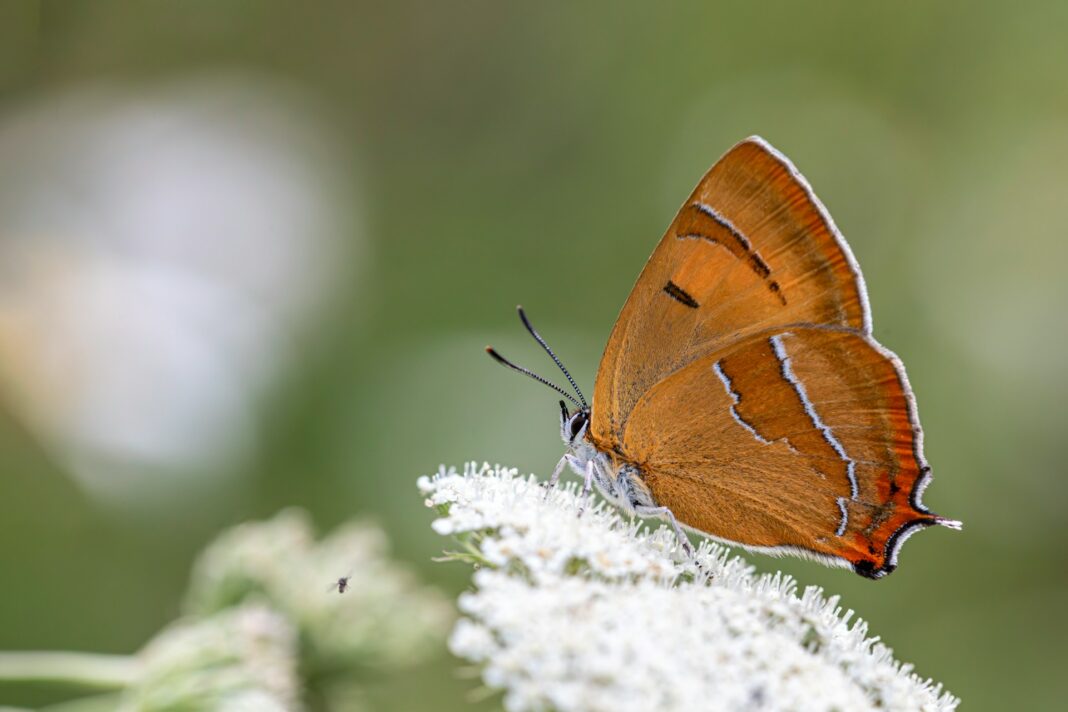In April 2025, a new, geographically isolated species of butterfly, known as the Curiously Isolated Hairstreak butterfly, was identified in Waterton Lakes National Park. This butterfly species was found in a grassland area called the Blakiston Fan.
Physical Characteristics:
This small butterfly has brown wings with black spots surrounded by white rings on the inside. The wingspan of male curiously isolated hairstreaks is 25 mm, while that of the females is slightly larger and paler.
The name “Hairstreak” pertains to the hair-like tails that are present on the forewings of this butterfly species.
Habitat and Niche:
The only known population of Curiously Isolated Hairstreak lives 400 km away from its closest relative, the Half Moon Hairstreak butterfly in British Columbia and Montana. The Curiously Isolated Hairstreak’s habitat is confined to the alluvial grasslands of the Blakiston Fan. An alluvial fan is a cone-like deposit of sediments falling from a steeper, valley-like area to a wider, flat area. The Blakiston Fan is at the edge of the mountains in Waterton Lakes National Park.
Along with occupying a distinct habitat, isolated from other butterfly species, the Curiously Isolated Hairstreak relies upon a different host plant, the silvery lupine. It is also in a symbiotic relationship with an ant species, Lasius ponderosae. The butterfly larvae produce a sugary substance called honeydew for the ants, while the ants protect the larvae from parasites.
Distinct Genetic Patterns:
Previously, this butterfly species was categorized as a subspecies of the half-moon hairstreak butterfly. However, researchers from the Wilder Institute/Calgary Zoo analyzed all the DNA sequences of the insects in the Blakiston Fan region and found that the curiously isolated hairstreak was both genetically and geographically isolated from other butterfly species more than 40,000 years ago.
When a single species becomes geographically isolated, it experiences different selective pressures in its environment. Consequently, they develop different adaptations and are unable to reproduce with each other, leading to the formation of new species.
Significance of this discovery and next steps:
Although the discovery of this new species is a step forward towards biodiversity conservation efforts, the highly specialized niche that the butterfly occupies makes it an endangered species.
As the population of the Curiously Isolated Hairstreak has been critically low throughout history, its genetic pool has low diversity. Low genetic diversity is a result of inbreeding and genetic drift, which can occur in low population sizes. Decreased genetic diversity also reduces the population’s ability to adapt to climatic or habitat changes, making conservation efforts more challenging.
According to the Wilder Institute, tailored, site-specific conservation strategies would be the next step forward in the conservation of this unique species.
As well, Parks Canada and the Wilder Institute/Calgary Zoo are collaborating to better understand the life stages and ecological interactions to make conservation decisions and plans.
What can you do?
According to Parks Canada, these two steps are the best way to stop the spread of invasive species that can affect the butterfly species’ survival.
- Ensure your hiking gear is clean and free of plant matter.
- Staying on marked roads and hiking trails.
TL;DR
The discovery of the Curiously Isolated Hairstreak is a step forward for Canadians to preserve our biodiversity. Although much more study and care are required to ensure that the newly identified butterfly species thrives, this discovery emphasizes the power of genetic tools and research collaborations in conserving Canada’s rich ecosystems.
Sources:
Curiously isolated hairstreak butterfly – Waterton Lakes National Park
SECRETS OF THE BLAKISTON FAN: ISOLATED BUTTERFLY REVEALED AS NEW SPECIES | Wilder Institute
‘Curiously isolated’ butterfly species discovered in Waterton Lakes National Park | CBC News
Curious animal isolated for 40,000 years found living in Rocky Mountains | Discover Wildlife

